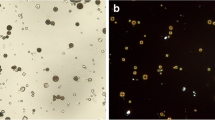Summary
Adenine phosphoribosyltransferase (APRT) deficiency leading to 2,8-dihydroxyadenine (DHA) urolithiasis has been considered a rare cause of urolithiasis and renal insufficiency. We have examined samples from 19 Japanese families with DHA lithiasis. In 79% of the families, patients only partially lacked hemolysate APRT activities, clearly contrasting with the complete deficiency in all the patients from non-Japanese families so far reported. All patients with DHA lithiasis were homozygotes for defective APRT genes, whether the deficiency was complete or partial. In family studies we found two symptomatic and four asymptomatic homozygous family members. The segregation figures are compatible with the hypothesis of a simple autosomal recessive mode of inheritance. By analyzing the data stored by a large clinical laboratory in Japan, we estimated that 0.00368% of the general population has DHA lithiasis. These data indicate that more than 1% of the general population possess mutant alleles of the APRT gene as heterozygotes. Our present studies indicate that most of the patients with this disease are undiagnosed in Japan, and probably in other countries also.
Similar content being viewed by others
References
Cartier P, Hamet M (1974) Une nouvelle maladie metabolique: le deficit complete en adenine-phosphoribosyltransferase avec lithiase de 2,8-dihydroxyadenine. CR Acad Sci [D] (Paris) 279:883–886
Emmerson BT, Gordon RB, Thompson L (1975) Adenine phosphoribosyltransferase deficiency in man: its inheritance and occurence in a female with gout and renal disease. Aust NZ J Med 5:440–446
Fox IH, Meade JC, Kelley WN (1973) Adenine phosphoribosyltransferase deficiency in man. Report of a second family. Am J Med 55:614–620
Fujimori S, Akaoka I, Sakamoto K, Yamanaka H, Nishioka K, Kamatani N (1985) Common characteristics of mutant adenine phosphoribosyltransferase from four separate Japanese families with 2,8-dihydroxyadenine urolithiasis associated with partial enzyme deficiencies. Hum Genet 71:171–176
Fujimori S, Akaoka I, Takeuchi F, Kanayama H, Tatara K, Nishioka K, Kamatani N (1986) Altered kinetic properties of a mutant adenine phosphoribosyltransferase. Metabolism 35:187–192
Gault MH, Simmonds HA, Snedden W, Dow D, Churchill DN, Penney H (1981) Urolithiasis due to 2,8-dihydroxyadenine in an adult. N Engl J Med 305:1570–1572
Hashinaka T, Ooka K, Takahara S, Nagaho S, Fukunishi T, Koide T (1982) 2,8-Dihydroxyadenine stones found in resected kidneys of a patient who underwent renal implantation (in Japanese). Jpn J Urol 73:1244
Henderson JF, Miller HR, Kelley WN, Rosenbloom FM, Seegmiller JE (1968) Kinetic studies of mutant human erythrocyte adenine phosphoribosyltransferases. Can J Biochem 46:703–706
Ito T, Sugimoto T, Maekawa M, Horii A, Yasumoto R (1985) A case of right ureteral stone with complete deficiency of adenine phosphoribosyltransferase (in Japanese). Acta Urol Jpn 31:1453–1458
Johnson LA, Bordon RB, Emmerson BT (1977) Adenine phosphoribosyltransferase: a simple spectrophotometric assay and the incidence of mutation in the normal population. Biochem Genet 15:265–272
Kamatani N, Takeuchi F, Nishida Y, Yamanaka H, Nishioka K, Tatara K, Fujimori S, Kaneko K, Akaoka I, Tofuku Y (1985) Severe impairment in adenine metabolism with a partial deficiency of adenine phosphoribosyltransferase. Metabolism 34:164–168
Kamatani N, Yamanaka H, Nobori T, Nishioka K, Fujimori S, Akaoka I, Mikanagi K (1986) Common altered characteristics of mutant enzymes from patients with Japanese type APRT deficiencies. In: Nyhan WL, Thompson LF, Watts RWE (eds) Purine and pyrimidine metabolism in man, vol 5. Plenum Press, New York, pp 39–46
Kondo K, Kamei Y, Fujita Y, Takemoto H (1981) Studies on urinary tract calculi: analysis of the composition of urinary tract calculi (in Japanese). Nishi-Nihon J Urol 43:929–932
Mitsuno S, Kido K, Okamura T, Inatomi H, Kaneko Y, Enomoto M (1986) 2,8-Dihydroxyadenine urolithiasis associated with an incomplete adenine phosphoribosyltransferase deficiency: report of a case (in Japanese). Nishi-Nihon J Urol 48:537–542
Nobori T, Kamatani N, Mikanagi, K, Nishida Y, Nishioka K (1986) Establishment and characterization of B cell lines from individuals with various types of adenine phosphoribosyltransferase deficiencies. Biochem Biophys Res Commun 137:998–1005
Noro T, Kamura M, Matsuoka T, Kawamura T, Ikawa F, Seki K, Ichino M, Suzuki K (1981) Micro-crystals of 2,8-dihydroxyadenine in the urinary sediment from severe deficiency of adenine phosphoribosyltransferase (in Japanese). Biomed J (Tokyo) 5:111–117
Sakamoto K, Fujisawa Y, Ohmori A, Minoda K, Yamanaka H, Nishioka K (1981) Dihydroxyadenine urolithiasis in chidren with partial deficiency of adenine phosphoribosyltransferase. Urol Int 36:274–280
Satoh K, Kageyama S, Nisimura Y, Fukusi Y, Kuwahara M, Miyabayasi S, Narisawa K (1983) A case of 2,8-dihydroxyadenine stone in a child with a partial deficiency of adenine phosphoribosyltransferase. Nishi-Nihon J Urol 45:421–425
Shirane Y, Hiraishi K, Kurokawa K (1982) Studies on components and composition of urinary calculi: analysis of 1167 samples by infrared spectroscopy (in Japanese). Nishi-Nihon J Urol 44:703–711
Simmonds HA, Van Ackar KJ (1983) Adenine phosphoribosyltransferase deficiency: 2,8-dihydroxyadenine lithiasis. In: Stanbury JB, Wyngaaden JB, Fredrickson DS (eds) Metabolic basis of inherited disease. McGraw-Hill, New York, pp 1145–1156
Srivastava SK, Billacorte D, Beutler E (1972) Correlation between adenylate during blood storage in various media. Transfusion 12:190–197
Szonyi P, Berenyi M, Toth J (1985) A rare enzyme deficiency causing formation of 2,8-dihydroxyadenine (purine body) calculi. Int Urol Nephrol 17:231–233
Thomas CB, Arnold WJ, Kelley WN (1973) Human adenine phosphoribosyltransferase. J Biol Chem 319:2529–2535
Witten FR, Morgan JW, Foster JG, Glenn JF (1983) 2,8-Dihydroxyadenine urolithiasis: review of the literature and report of a case in the United States. J Urol 130:938–942
Yamamoto H, Hiraishi K, Shirane Y, Sumiyoshi Y, Nakamura S, Higa I, Yamanaka H (1982) Two cases of 2,8-dihydroxyadenine stone (in Japanese). Uric Acid Res 5:62–68
Yoshida O (1979) Epidemiology of urolithiasis in Japan (in Japanese). Jpn J Urol 70:975–983
Author information
Authors and Affiliations
Rights and permissions
About this article
Cite this article
Kamatani, N., Terai, C., Kuroshima, S. et al. Genetic and clinical studies on 19 families with adenine phosphoribosyltransferase deficiencies. Hum Genet 75, 163–168 (1987). https://doi.org/10.1007/BF00591080
Received:
Revised:
Issue Date:
DOI: https://doi.org/10.1007/BF00591080




